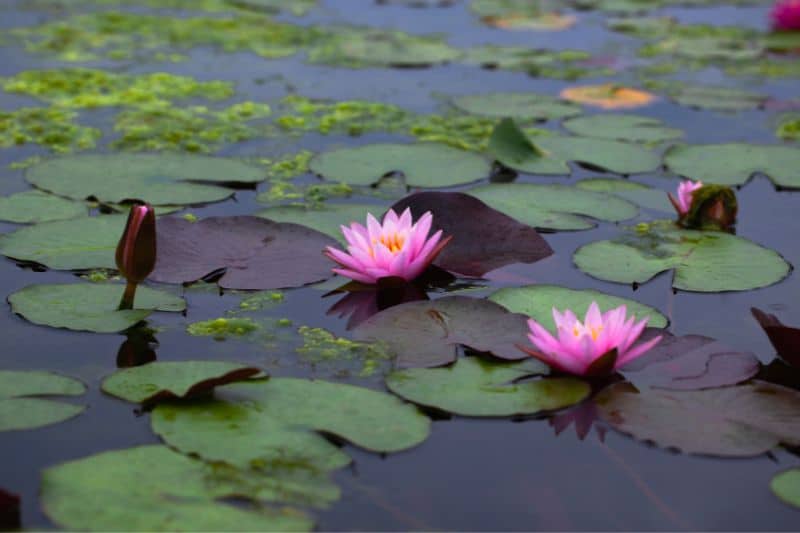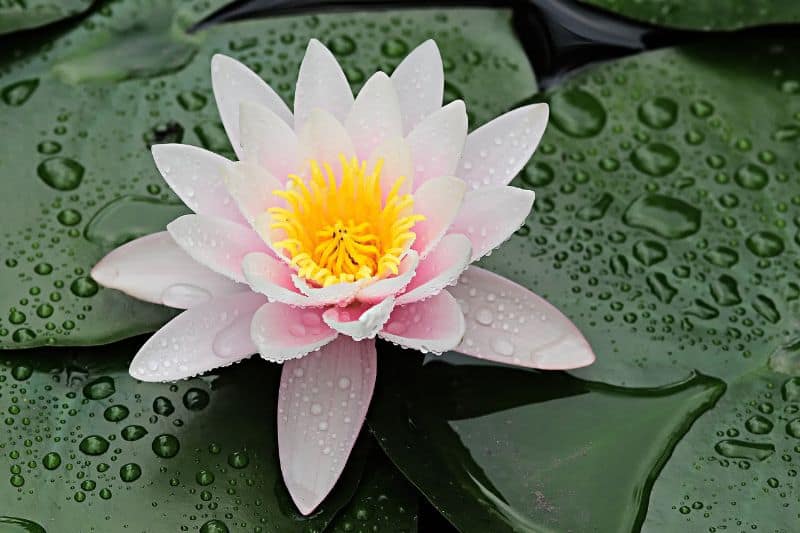Lilies bring color and uniqueness to your garden thanks to their bright, star-shaped flowers. These plants, which have long blooming seasons, are known in Chinese culture as symbolizing love and good luck. Gardeners love them because they’re versatile, as you can grow them in the ground or pots. But, do lilies need full sun to grow?
Lilies need lots of sun to bloom and grow to their full potential. Lilies need many hours of sunlight every day, or their growth will be stunted. However, some lily varieties require more sun than others.
Read: How Long Do Olive Trees Live?
Do Lilies Need Full Sun or Shade?
Lilies generally need full sun instead of too much shade. They should be planted in a sunny and hot area of the garden to encourage their growth. Full-sun conditions also stimulate the plant to grow flowers.
However, what some gardeners don’t realize about growing lilies is that they do best when their flowers are in the sun and their roots are in the shade. This protects their roots by preventing them from drying out.
When planting lilies, do so in a sunny area of the garden, but plant perennial grasses around them to shield their roots from too much sun.
Can Lilies Grow in Shade?
Lilies can grow in the shade, but many plant varieties won’t perform as well as in full-sun conditions. If they don’t have enough sunshine every day, lily plant stems will start leaning towards the sun, and this can weaken the plants.
If you don’t have much sun in your garden, look for some lily varieties that grow better in shade than others. These include:
- Toad Lilly. This lily variety is a perennial that thrives in the shade. It grows flowers that look like orchids. When growing it, plant it in consistently moist but well-draining soil.
- Asiatic Lilies. This plant variety has bright, spotted petals on flowers that can be bowl-shaped or curved. Although they can grow in full sun, they also do well in part-shade conditions.
- Martagon Lily. This unusual-looking lily variety can be found in various colors, such as lavender and pink, and it has curled petals. It can be grown in sunny or part-shade conditions.

Can Lilies Grow in Indirect Light?
Lilies can grow in indirect light conditions. This makes them versatile plants because you can grow them indoors. A variety of lily that grows well indoors is the Peace Lily, which doesn’t require bright, direct light.
When growing lilies indoors, ensure you place them close to a window so they will get bright, indirect light, such as sunlight that’s filtered through a curtain.
However, remember that if you plant your lily in too much indirect light, it might struggle to produce many blooms. If you see your plant becoming leggy, meaning that its stems are stretching toward the nearest light source, it requires more sun and should be moved into a brighter area.
How Many Hours of Sun Do Lilies Need?
Lilies need between six and eight hours of sunshine every day. If you don’t give them enough sun, they will become leggy or they won’t bloom. Lilies do best in the morning sun and should be protected from the harsh afternoon sun in climates that experience hot summers.
So, if you’re growing them in a sunny area, but temperatures tend to soar in your region, make sure they get some shade, such as from tall trees planted close to them.
If you’ve chosen a lily variety that doesn’t require full sun, you can plant it in semi-shade conditions or areas of dappled sunlight. This type of sunlight can be defined as diffused light, such as the sunlight that shines through the leaves of trees or larger plants.
Can Lilies Get Too Much Sun?
Lilies can get too much sun, which can scorch their flowers and leaves. You can tell your lilies are getting too much sun if their leaves are turning yellow or the plant is drooping.
Lily varieties that are more suitable for shaded areas, such as the Peace Lily, are especially susceptible to damage from the sun. These should be protected from the sun by being kept in areas of indirect, bright light.
In the garden, ensure you protect your lily plants if you can see that they’re struggling during periods of high temperatures. You can do this by planting them next to structures, such as a wall that blocks harsh light during the day.

How To Grow & Care For Lily Plants
You can grow and care for lily plants by ensuring that you give them the correct amount of water, the correct soil, and essential nutrients they require. Although lilies appear to be high-maintenance, they’re really easy for gardeners to look after, making them great for beginners.
To grow beautiful, healthy lily plants, here are some important tips.
Soil Requirements
Lilies need to be planted in an area with well-draining soil. These bulbs don’t want to be planted in heavy or soggy soil. The soil you use for your lily varies depending on the variety. For example, if you’re growing oriental lilies, they require slightly acidic soil. Generally, though, lilies aren’t too fussy about having certain soil pH levels or soil types.
Water Requirements
Lilies need to be watered every two days, but don’t overwater them as this can cause them to develop root rot. Before watering them, check the surface inch (2.54cm) of soil. If it feels dry, you should grab your watering can. If your area is experiencing a drought, you should increase the water you give your plants.
If the soil of your lily feels soggy a few days after you’ve watered it, that’s a red flag that you’re giving your plant too much water. Let the soil dry out properly before watering it again.
When watering your lilies, direct the water to the soil so you don’t splash their leaves, as this can result in fungal diseases.
Climate Requirements
Lilies grow best in areas that experience cold winter seasons and warm summers, but they don’t like humidity. If you live in a tropical region, you should plant lilies in pots or containers so you can move them to a cooler area of the home when the weather is hot and humid.
Lily plants are susceptible to strong winds that can break their delicate stems. This is why you should plant them in a spot in the garden where they’ll be protected from gusts of wind.
Fertilizer Requirements
Lilies require regular fertilizer. You should apply a slow-release fertilizer to their soil during the growing season, which is early spring, after some new growth has appeared on the plant. Avoid using a nitrogen-rich fertilizer, as this can cause the plants to grow too many leaves and no flowers.
Mulching Requirements
Applying a two-inch (5.08cm) layer of mulch around the base of your lily plants is recommended. This will keep the soil and roots cool during hot days while helping the plant to maintain its moisture. However, don’t apply mulch to the plant’s stem, as this can lead to rot.
Planting Requirements
You should plant lilies a few weeks before the first frost is scheduled in your area or during the springtime when the last frost has already passed.
- Plant the lily bulbs with their pointy side facing upwards.
- Put them deep into the soil – roughly twice as deep as their bulb size. This means that if the bulb is two inches (5.08cm) tall, you should plant it four inches (10.16cm) into the soil.
- After planting your lilies, apply mulch to the soil to keep their roots cool and to protect their delicate bulbs.
Staking Requirements
If you’re growing tall lily varieties, you should stake them so that they don’t wilt or droop because of their heavy flowers. Place a stake near the lily plant’s stem and tie it to the plate with a bit of twine.
Read: Do Pine Trees Have Deep Roots?
Pruning Requirements
Lily plants don’t require pruning, but their faded flowers should be removed. By removing brown and dead flowers from the plant, you’ll prevent it from using energy to produce more seeds.
Winterization Requirements
You don’t have to worry too much about protecting your lilies during the cold months unless you live in a region that experiences extremely low temperatures. In this case, cover the lily plant’s base with more mulch so that its roots will be protected during the winter.
Growing Lilies in Containers
If you’re growing lilies in containers or pots, there are some extra tips to bear in mind.
- Choose a container with drainage holes. You can also add a layer of stones or rocks at the bottom of the container to encourage drainage. This will also help to keep taller lily varieties stable.
- Add a slow-release fertilizer to the soil. This should be applied to the soil’s surface layer to encourage healthy growth.
- Choose a container that’s about 15 inches (38cm) deep to give your lily plant enough space for its roots to grow.






